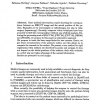Free Online Productivity Tools
i2Speak
i2Symbol
i2OCR
iTex2Img
iWeb2Print
iWeb2Shot
i2Type
iPdf2Split
iPdf2Merge
i2Bopomofo
i2Arabic
i2Style
i2Image
i2PDF
iLatex2Rtf
Sci2ools
90
Voted
CVRMED
1995
Springer
1995
Springer
A New Framework for Fusing Stereo Images with Volumetric Medical Images
Abstract. Some medical interventions require knowing the correspondence between an MRI/CT image and the actual position of the patient. Examples are in neurosurgery or radiotherapy, but also in video surgery (laparoscopy). Recently, computer vision techniques have been proposed to find this correspondence without any artificial markers. Following the pioneering work of [GLPI+94], [CZH+94], [CDT+92], [SHK94] and [STAL94], we propose in this paper an alternative approach. We propose to trade the laser range finder for two cameras. Hence, we get dense reconstruction of the patient's surface and this allows us to compute the normals to the surface. We present a new method for rigid registration when surfaces are described by points and normals. It does not depend on the initial positions of the surfaces, deals with occlusion in a strict way and takes advantage of the normal information. Results are presented on real images.
Related Content
| Added | 26 Aug 2010 |
| Updated | 26 Aug 2010 |
| Type | Conference |
| Year | 1995 |
| Where | CVRMED |
| Authors | Fabienne Betting, Jacques Feldmar, Nicholas Ayache, Frederic Devernay |
Comments (0)

